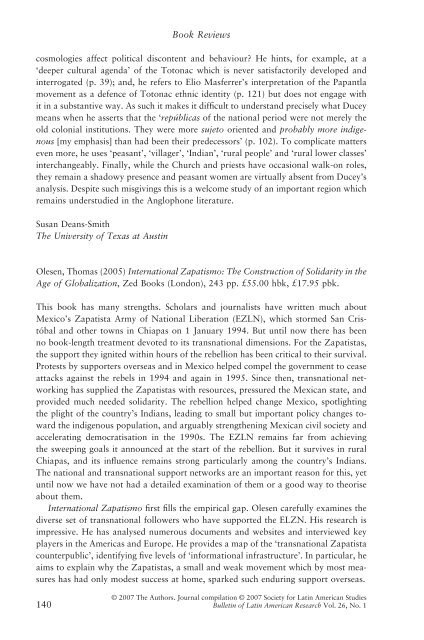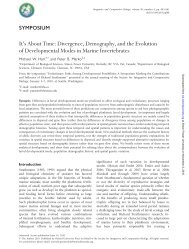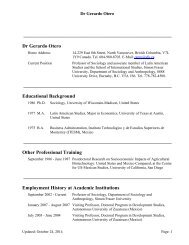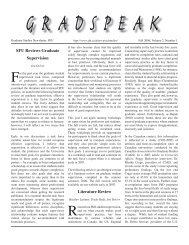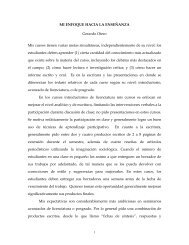Review of Mexico in Transition by Byron Crites
Review of Mexico in Transition by Byron Crites
Review of Mexico in Transition by Byron Crites
- TAGS
- transition
- byron
- crites
- cgi.sfu.ca
Create successful ePaper yourself
Turn your PDF publications into a flip-book with our unique Google optimized e-Paper software.
Book <strong>Review</strong>s<br />
cosmologies affect political discontent and behaviour? He h<strong>in</strong>ts, for example, at a<br />
‘ deeper cultural agenda ’ <strong>of</strong> the Totonac which is never satisfactorily developed and<br />
<strong>in</strong>terrogated (p. 39); and, he refers to Elio Masferrer ’ s <strong>in</strong>terpretation <strong>of</strong> the Papantla<br />
movement as a defence <strong>of</strong> Totonac ethnic identity (p. 121) but does not engage with<br />
it <strong>in</strong> a substantive way. As such it makes it diffi cult to understand precisely what Ducey<br />
means when he asserts that the ‘ repúblicas <strong>of</strong> the national period were not merely the<br />
old colonial <strong>in</strong>stitutions. They were more sujeto oriented and probably more <strong>in</strong>digenous<br />
[my emphasis] than had been their predecessors ’ (p. 102). To complicate matters<br />
even more, he uses ‘ peasant ’ , ‘ villager ’ , ‘ Indian ’ , ‘ rural people ’ and ‘ rural lower classes ’<br />
<strong>in</strong>terchangeably. F<strong>in</strong>ally, while the Church and priests have occasional walk-on roles,<br />
they rema<strong>in</strong> a shadowy presence and peasant women are virtually absent from Ducey ’ s<br />
analysis. Despite such misgiv<strong>in</strong>gs this is a welcome study <strong>of</strong> an important region which<br />
rema<strong>in</strong>s understudied <strong>in</strong> the Anglophone literature.<br />
Susan Deans-Smith<br />
The University <strong>of</strong> Texas at Aust<strong>in</strong><br />
Olesen, Thomas (2005) International Zapatismo: The Construction <strong>of</strong> Solidarity <strong>in</strong> the<br />
Age <strong>of</strong> Globalization , Zed Books (London), 243 pp. £55.00 hbk, £17.95 pbk.<br />
This book has many strengths. Scholars and journalists have written much about<br />
<strong>Mexico</strong> ’ s Zapatista Army <strong>of</strong> National Liberation (EZLN), which stormed San Cristóbal<br />
and other towns <strong>in</strong> Chiapas on 1 January 1994. But until now there has been<br />
no book-length treatment devoted to its transnational dimensions. For the Zapatistas,<br />
the support they ignited with<strong>in</strong> hours <strong>of</strong> the rebellion has been critical to their survival.<br />
Protests <strong>by</strong> supporters overseas and <strong>in</strong> <strong>Mexico</strong> helped compel the government to cease<br />
attacks aga<strong>in</strong>st the rebels <strong>in</strong> 1994 and aga<strong>in</strong> <strong>in</strong> 1995. S<strong>in</strong>ce then, transnational network<strong>in</strong>g<br />
has supplied the Zapatistas with resources, pressured the Mexican state, and<br />
provided much needed solidarity. The rebellion helped change <strong>Mexico</strong>, spotlight<strong>in</strong>g<br />
the plight <strong>of</strong> the country ’ s Indians, lead<strong>in</strong>g to small but important policy changes toward<br />
the <strong>in</strong>digenous population, and arguably strengthen<strong>in</strong>g Mexican civil society and<br />
accelerat<strong>in</strong>g democratisation <strong>in</strong> the 1990s. The EZLN rema<strong>in</strong>s far from achiev<strong>in</strong>g<br />
the sweep<strong>in</strong>g goals it announced at the start <strong>of</strong> the rebellion. But it survives <strong>in</strong> rural<br />
Chiapas, and its <strong>in</strong>fl uence rema<strong>in</strong>s strong particularly among the country ’ s Indians.<br />
The national and transnational support networks are an important reason for this, yet<br />
until now we have not had a detailed exam<strong>in</strong>ation <strong>of</strong> them or a good way to theorise<br />
about them.<br />
International Zapatismo fi rst fi lls the empirical gap. Olesen carefully exam<strong>in</strong>es the<br />
diverse set <strong>of</strong> transnational followers who have supported the ELZN. His research is<br />
impressive. He has analysed numerous documents and websites and <strong>in</strong>terviewed key<br />
players <strong>in</strong> the Americas and Europe. He provides a map <strong>of</strong> the ‘ transnational Zapatista<br />
counterpublic ’ , identify<strong>in</strong>g fi ve levels <strong>of</strong> ‘ <strong>in</strong>formational <strong>in</strong>frastructure ’ . In particular, he<br />
aims to expla<strong>in</strong> why the Zapatistas, a small and weak movement which <strong>by</strong> most measures<br />
has had only modest success at home, sparked such endur<strong>in</strong>g support overseas.<br />
© 2007 The Authors. Journal compilation © 2007 Society for Lat<strong>in</strong> American Studies<br />
140 Bullet<strong>in</strong> <strong>of</strong> Lat<strong>in</strong> American Research Vol. 26, No. 1


